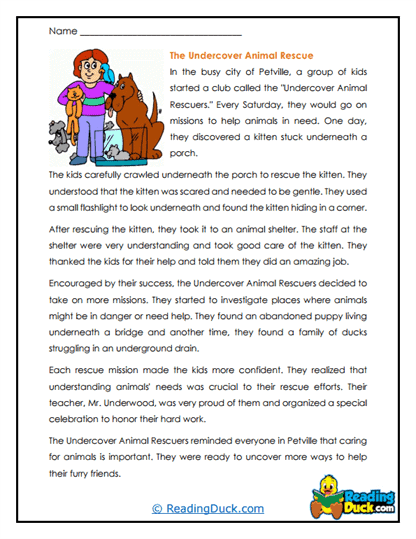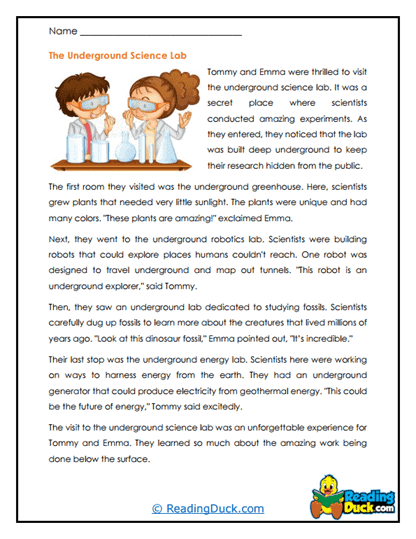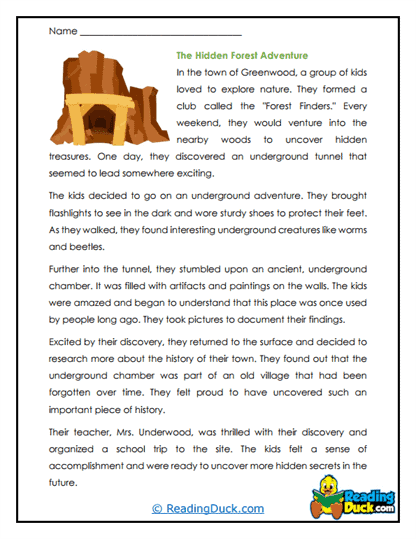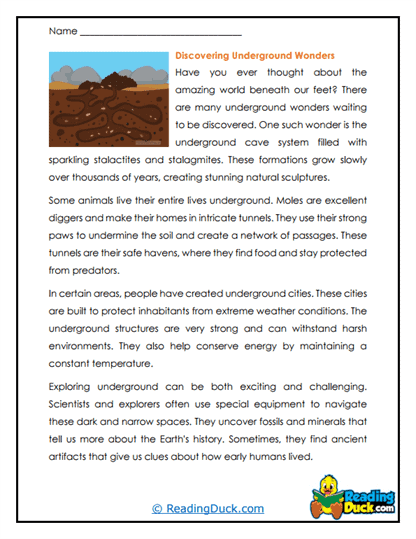Under- Prefix Reading Passages Worksheets
About Our Under- Prefix Reading Passages Worksheets
The Under- Prefix Reading Passages Worksheets are designed to help students master the meaning and usage of the "under-" prefix through engaging, targeted reading activities. Each worksheet features a carefully written reading passage that incorporates several words using the "under-" prefix, offering students clear examples of how this prefix changes the meaning of words. To further enhance engagement, each worksheet is accompanied by a vibrant picture that visually ties into the passage, helping students connect the content to the prefix being studied.
In addition to the reading passage, every worksheet includes multiple-choice questions that assess comprehension. These questions are designed to ensure that students not only recognize the "under-" prefix but also understand how it modifies word meanings in context. By focusing on comprehension, the worksheets reinforce both vocabulary development and the practical application of the prefix.
The worksheets are presented in PDF format, making them easy to download, view, and print. They are convenient to use in the classroom or at home. Each worksheet also includes a downloadable answer key for simple and efficient grading, making it easier for teachers, parents, and tutors to provide immediate feedback. These worksheets are an effective resource for deepening students' understanding of prefixes and enhancing their reading comprehension skills.
The Role of Prefixes in Vocabulary Development
Prefixes play a crucial role in helping students expand their vocabulary and improve their ability to decode unfamiliar words. A prefix is a group of letters added to the beginning of a word to change its meaning. By learning and recognizing prefixes, students can break down words more effectively and infer meanings based on the prefix and the root word.
For example, prefixes like "dis-," "pre-," "un-," and "re-" are some of the most commonly used in the English language. When students understand that "dis-" often means "not" or "opposite of," they can decode words like "dislike" (to not like) or "disagree" (to not agree). Similarly, the prefix "pre-" means "before," as in "preview" (to view beforehand) or "predict" (to say before something happens). Understanding these building blocks allows students to approach unfamiliar words in reading passages with more confidence.
Learning prefixes is essential for improving vocabulary and reading comprehension because it allows students to unlock the meaning of new words without relying solely on memorization. It helps them to make sense of the language's structure, leading to better fluency and overall literacy skills.
Exploring the Meaning of the Under- Prefix
The prefix "under-" commonly means "beneath" or "below," and it can also refer to something being less than, insufficient, or incomplete. This prefix is found in many everyday words and helps convey relationships of position, status, or amount. Understanding the "under-" prefix enables students to decode and use a wide range of words that describe things as being beneath, lesser, or not fully realized.
Some common examples of words using the "under-" prefix include:
- Underestimate: To estimate something as being less important or less in value than it truly is.
- Underwater: Situated or occurring beneath the surface of the water.
- Underpaid: Paid less than the value of the work done.
- Underdog: A competitor thought to have little chance of winning.
- Undergo: To experience or endure something, usually a process or change.
The Under- Prefix Reading Passages Worksheets provide students with multiple opportunities to see and practice using the "under-" prefix in different contexts. Through reading passages that feature words like "underestimate" and "underwater," students will gain a clearer understanding of how the prefix modifies word meanings, ensuring they can apply this knowledge in both reading and writing.
Key Features and Benefits of the Under- Prefix Worksheets
The Under- Prefix Reading Passages Worksheets offer a range of educational benefits that make them a valuable resource for improving vocabulary and reading comprehension. These worksheets are designed to give students ample opportunities to practice recognizing and using the "under-" prefix in meaningful, real-world contexts.
Here are the key features and benefits of the worksheets:
- Focused Reading Passages: Each passage is rich with words containing the "under-" prefix, providing students with clear examples of how the prefix changes the meaning of the base word.
- Engaging Visuals: Each worksheet is paired with a vibrant, engaging image that adds a visual dimension to the passage, helping students make connections between the prefix and its usage.
- Comprehension Questions: Multiple-choice questions are included to assess students’ understanding of the passage and the "under-" prefix. These questions reinforce the application of the prefix in context.
- PDF Format for Easy Access: The worksheets are easy to download, print, and distribute, making them perfect for classroom or home use.
- Answer Keys for Quick Grading: Each worksheet comes with a downloadable answer key, streamlining the grading process and providing immediate feedback for students.
These features ensure that students not only recognize the "under-" prefix but also understand how it functions in various words, improving their ability to decode unfamiliar vocabulary in reading passages.
Practical Strategies for Using the Worksheets
The Under- Prefix Reading Passages Worksheets are versatile and can be integrated into a variety of instructional strategies. Whether used for whole-class instruction, small group activities, or individual practice, these worksheets offer flexible options for helping students master the "under-" prefix.
Here are some practical ways to incorporate these worksheets into your literacy instruction:
- Whole-Class Instruction: Use the worksheets as part of a larger lesson on prefixes. Introduce the "under-" prefix and its meaning, then have students read the passage aloud as a class. Follow up by working through the comprehension questions together to reinforce understanding.
- Small Group Activities: Assign the worksheets to small groups, allowing students to read the passage and discuss how the "under-" prefix changes word meanings. This encourages peer learning and fosters deeper comprehension through group discussion.
- Independent Practice: The worksheets are ideal for independent practice, whether in class or as homework. Students can work through the passage and questions at their own pace, reinforcing their knowledge of the prefix in a focused, self-guided way.
- Supplementary Resource: Use the worksheets as a supplementary resource to support existing lessons on prefixes or vocabulary. They can also be used to introduce new prefixes or reinforce students' understanding of previously learned prefixes.
By using these worksheets in a variety of instructional settings, educators can provide students with consistent and meaningful practice that deepens their understanding of the "under-" prefix and enhances their overall reading fluency.
Incorporating the Worksheets Into a Broader Vocabulary Curriculum
The Under- Prefix Reading Passages Worksheets can play an important role in a broader vocabulary-building curriculum. Prefixes are critical to helping students develop a more comprehensive understanding of how language works. By systematically introducing students to common prefixes—such as "under-," "re-," "pre-," and "un-"—teachers can equip students with the skills they need to decode a wide range of unfamiliar words.
A well-structured vocabulary curriculum incorporates regular practice with prefixes, ensuring that students are exposed to new prefixes over time. By practicing with the "under-" prefix in different contexts, students will learn to recognize patterns in word formation and apply their knowledge to increasingly complex vocabulary. This approach promotes long-term retention and helps students build stronger reading skills overall.
By including the Under- Prefix Reading Passages Worksheets as part of a broader curriculum, educators can provide students with repeated exposure to key prefixes, helping them to track their progress and strengthen their understanding of how language is structured.
Strengthening Reading Fluency and Comprehension Through Prefixes
Understanding prefixes like "under-" is essential for improving reading fluency and comprehension. Prefixes provide critical clues that help students decode unfamiliar words, allowing them to understand the meaning of a passage more easily. When students are familiar with common prefixes, they can quickly infer the meaning of new words without needing to pause and consult a dictionary.
For example, if a student knows that "under-" means "beneath" or "below," they can quickly figure out that "underwater" refers to something below the surface of the water and that "underestimate" means to undervalue or underrate something. This ability to decode words independently enhances reading fluency and enables students to engage with more complex texts.
The Under- Prefix Reading Passages Worksheets provide ample opportunities for students to practice using the "under-" prefix in real-world reading scenarios, helping them to strengthen both their vocabulary and their comprehension skills.
Conclusion: Strengthen Vocabulary with Under- Prefix Reading Passages
The Under- Prefix Reading Passages Worksheets offer a practical and engaging way for students to expand their vocabulary and improve their reading comprehension skills by mastering the "under-" prefix. With targeted reading passages, visually engaging images, and comprehension questions, these worksheets provide a structured and effective learning experience.
Whether used in the classroom, for small group activities, or for independent practice, these worksheets are a versatile resource that supports vocabulary growth and reading fluency. By incorporating them into a broader vocabulary curriculum, educators can help students build the skills they need to decode and understand complex words with confidence, making them more capable, proficient readers.









